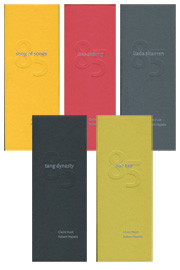Song of Songs (85)
Claire Huot
Robert Majzels
1 of 5 book set, 85
Binding: Hardcover, Anstey Bookbinding
Paper: Lynx Opaque
Edition Size: 200 | Pages: 22 [accordion]
Size: 8.75 x 3.25
Visual Poetry | $50.00
ISBN 987-1-934254-44-8
Original page designs by Robert Majzels
85 set box designed and manufactured by Nathan Tremblay
Published simultaneously in Canada by Moveable Inc.
View the full 85 set here.
In their new translation of passages from the Song of Songs, Robert Majzels and Claire Huot focus on the materiality and semantic multiplicity of the Torah’s most poetic and erotically charged book. Choosing select verses from their source text and reducing these verses to 85-letter blocks uninterrupted by word breaks or punctuation, the translators transform the language of the original into a tangible, material substance. This whittling down of language yields works of powerful, concentrated effect, works in which each individual letter achieves its own sacred presence on the page. The texts become layered, dense, and infinitely interpretable, implicating the reader and causing him or her to slow down, forcing him or her to acknowledge the physicality and visuality of the letters themselves and the relations between them. The color of the Hebrew letters on these 85s echoes the sands and palimpsests of that ever shifting tradition.
Although the primary goal of 85 is to transform Chinese poems into visual poetry in English, the project’s translational approach is inspired by the ancient Talmudic principles of reading and interpretation, which date back to the origins of Western civilization. It is from the Hebrew Torah, with its absence of punctuation or spaces between the letters that the 85 project draws its formal inspiration. The constraint of 85 letters is based on a biblical passage (Numbers: 10:35-36) containing that same number of letters, and which the Talmudic sages have identified as a displaced book within The Book, a text under erasure and in perpetual movement. The essence of the book, like that of the Ark of the Covenant, which contains the Law of Moses, and which is the subject of the biblical passage cited above, is meaning in continual movement. Hence, this series of 85s from the Song of Songs finds its place alongside the translations of Bada Shanren, Xue Tao, Mao Zedong, and various poets from the Tang Dynasty which make up the project’s other four volumes. As in their handling of works in Chinese, the translators here adopt an approach to the world, the self, and the Other that is radically open-ended, nonlinear, and materialist—a practice evoked by the visual layout of the texts, which enacts the difficult negotiation of the reception in English of poetic works in other languages.
As with the four other limited edition volumes of 85, Song of Songs is printed on Lynx Opaque, an acid-free paper with superior longevity. Hardcover, with accordion fold binding and exquisitely embossed titles, it is a work of visual text-art in its own right, the minimalism and beauty of its material form complementing and illuminating the radical act of poetic exploration that the volume contains.
What happens when we come face to face with the Other? Do we consume the other culture and come away unchanged, or do we allow our language, culture, and selves to be transformed, stretched to include new forms and meanings? The answer depends on our willingness to do the hard work of reading. 85 is a poetic exploration into the way one language and culture—in this case English—perceives and receives another—in this case Chinese. The work is grounded in a radical translational approach based on contemporary philosophical theories that return to the Judaic roots of Western civilization. This approach to the world, the self, and the Other is open-ended, nonlinear, and materialist—a practice evoked by the visual layout of the texts, which enacts the difficult negotiation of the reception in English of Chinese poetic works.




